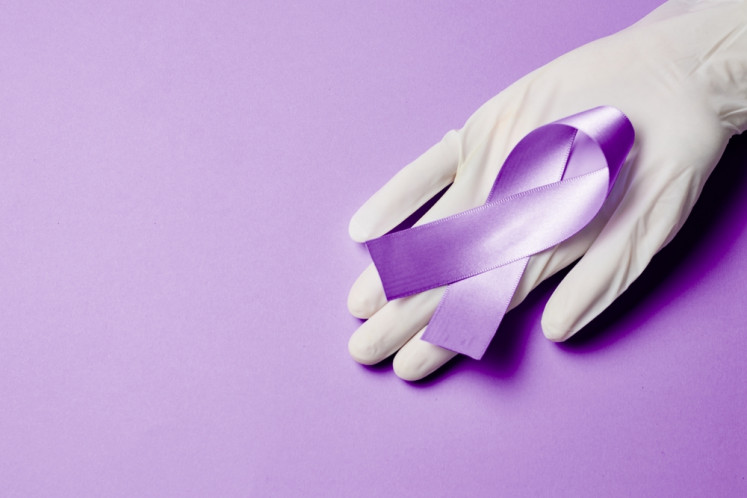Popular Reads
Top Results
Can't find what you're looking for?
View all search resultsPopular Reads
Top Results
Can't find what you're looking for?
View all search resultsBasoeki Abdullah's Love of Javanese culture revisited
Young and senior artists are exhibiting their works with Indonesian realism maestro Basoeki Abdullah in mind
Change text size
Gift Premium Articles
to Anyone
Young and senior artists are exhibiting their works with Indonesian realism maestro Basoeki Abdullah in mind.
An ongoing art exhibition, themed 'Legacy of Javanese Culture', is being held as part of celebrations marking maestro Basoeki Abdullah's birth centennial this year.
Five of his paintings that immortalize the mythical tales, kings and beauties of Javanese culture are on display at Galeri Rumah Jawa in Kemang, South Jakarta until Sept. 15, side-by-side with artworks that were inspired by them.
The exhibition's curator, Bambang Asrini Widjanarko, says the artists taking part in the event have revisited and reinterpreted the Javanese philosophies adopted by Basoeki.
As the grandson of national education hero and physician Wahidin Sudirohusodo, Basoeki was raised in a noble Javanese family that focused on holding and safeguarding the traditional arts and cultures.
He was only 18 when he painted Gatotkaca versus Antasena in 1933, a painting that won him a scholarship to study at the Hague.
Basoeki was later appointed as palace artist by first president Sukarno and, according to Bambang, painted an estimated 5,000 paintings; many of them were portraits of acquaintances and the president's guests.
However, only about 100 of his paintings have been secured at the Basoeki Abdullah Museum, which was established after his death in 1993.
Basoeki's works, he said, are known worldwide but many Indonesians do not know who he is. 'This exhibition hopes to remind us all of his work and his contribution to the art world,' Bambang said.
Rahwana and Shinta by Basoeki Abdullah
Basoeki's paintings on display at the exhibition are the portrait of his grandfather, the portrait of modern Javanese king Sultan Hamengkubuwono IX, Gatotkaca and Arjuna's daughters (Pergiwa and Pergiwati), Rahwana and Shinta, as well as Woman in Yellow Kebaya and Purple Shawl.
Basoeki Abdullah Museum head Joko Madsono says the paintings represent the maestro's take on his culture and the Javanese people.
'No one recognizes the model for the woman in the yellow kebaya (blouse) but many people thought that she was actually a Sundanese and called the painting Wanita Sunda (Sundanese woman) instead. However, the colors are the symbol of Javanese royalty,' he says.
Although the famous painting of the battle between the two brothers in Javanese myth was not on display for a comparison, Balinese painter Ida Bagus Putu Purwa added the motion of flesh into the image, making it larger both in size and intensity.
He also interpreted Basoeki's work in Rahwana and Shinta by softening the tone of the fight between the mythical bird Jatayu and Rahwana the beast and turning the fight into a romantic story.
While the original painting shows a face-to-face duel with unconscious Shinta in the middle, Putu Purwa explores the other side of Rahwana, who is gently holding a water lily (Shinta) and allows Jatayu to scratch his back in doing so.
Rosid penciled the portrait of Basoeki Abdullah on a wooden table top for the exhibition and offered a new interpretation of the Javanese fighter Pangeran Diponegoro. Also with pencil, the artist places the drawing of the prince's portrait on batik cloth with four different motifs.
Abdi Dalem (Royal servant)by I Gusti Nengah Sura Ardana
'The artist depicts the prince with special emphasis on his Javanese characteristics,' says Bambang.
The participating artists also imitate the flamboyant maestro's Mooi Indie style of painting nude women and natural landscapes and adopt it into their work, leaving out the eroticism.
Indyra's Gadis Solo (Solo's girl), for example, shows the authentic hand movement of a Surakarta palace dancer but the shadowy green colors used in the painting emulate Basoeki's style to generate an aura of mysteriousness about the woman.
Neneng Ferrier has created a sculpture that looks like a bonsai-ed tree, but the flowers grow on the trunk.
Graphic artist and painter Sudigdo also plays with symbols in his Javanese Bride ' a canvas full of a woman's face wearing the special makeup for a bride with batik motifs printed on her skin ' and Ready, a painting that depicts a woman wearing batik lying on a plate.
'Bride is a reminder of the fading of Javanese culture in its wedding rituals, even in the villages. Javanese people now comprehend their culture in terms of outer attributes only, without understanding its deeper values.
'For Ready, there are at least two ways to look at it. First, a woman is always shallowly associated with home cooking and second, a woman, from time immemorial, is the object of gratification,' he says.
Sudigdo, and most of the artists in the exhibition, will also take part in Basoeki's birth centennial celebration event. An exhibition at the National Museum starting from Sept. 21 will further unfurl the layers of his work.
'I will bring my own interpretation on the Wanita Sunda painting. I will give it a new title, Golden Woman, and put the painting behind a door,' says Sudigdo.
Javanese Bride by Sudigdo
' Photos by JP/Tertiani ZB Simanjuntak














